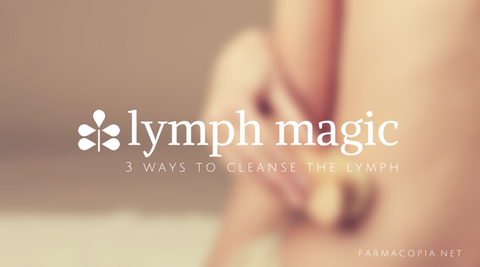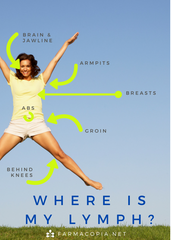 Author: Lily Mazzarella
Author: Lily MazzarellaWe’re having a heat wave. There’s no AC in northern California, and the house is 89 at bedtime. I’m at the height of my allergy season. After a moist, restless night I wake, stiff, with a headache and a puffy face covered in pillow creases. This is the kind of morning I want nothing more than to be handed a triple espresso and told that I don’t have to go to work. After shuffling about, sausage-like, for a while, I decide to take matters into my own hands.
Or rather, a soft-bristled brush: I head into the bathroom, and embark on a ritual that—when I remember to do it—is always a game-changer. I perform lymph magic.
What is this lymph you speak of?
 The lymph system is our under appreciated workhorse—our built-in recycling and waste removal system. “Silent partner” to the cardiovascular system, this system of close-ended vessels picks up fluid in our tissues that leaks out of capillaries, filters it for pathogens and waste products in the lymph nodes, and returns it to general circulation. So, there are “immune” aspects to lymph, as well as detox aspects. Unlike the cardiovascular system, the lymphatics do not have a central pump (a.k.a., the heart)—and must rely upon US to keep it moving.
The lymph system is our under appreciated workhorse—our built-in recycling and waste removal system. “Silent partner” to the cardiovascular system, this system of close-ended vessels picks up fluid in our tissues that leaks out of capillaries, filters it for pathogens and waste products in the lymph nodes, and returns it to general circulation. So, there are “immune” aspects to lymph, as well as detox aspects. Unlike the cardiovascular system, the lymphatics do not have a central pump (a.k.a., the heart)—and must rely upon US to keep it moving.
Inflammation leads to leaky capillaries and more waste products in our tissues, which causes fluid to accumulate there, creating more work for the lymph system. We used to think the brain was exempt from this system—cut off by the “blood-brain-barrier”—in order to protect the brain from potentially dangerous pathogenic and inflammatory material. But amazingly, in recent months, a new anatomical discovery was made: there are in fact lymph channels bathing the brain, and they connect up with the rest of the body’s lymph system. This means that there can be clean-up in the brain (woo-hoo!), but also that antigenic and waste components of lymph can make contact with this sensitive tissue (boo!). As we begin to understand the deleterious effects of chronic inflammation on the brain, this finding takes on massive importance.
We want clean, flowing lymph!
 Top 3 ways to perform lymph magic
Top 3 ways to perform lymph magic
My favorite lymph ritual takes less than 15 minutes, and immediately improves my energy and outlook.
1. Dry-brushing
You will need a natural, soft-bristled wooden brush—commonly available at natural food stores. You can also use exfoliating gloves or even a rough washcloth, but I like the brush best, as it allows me to reach my back.
For optimal lymph flow, start with your extremities and move towards your heart. Brush from the tops of your feet upwards; then make sure to get the backs of legs. Brush your abdomen, arms (starting with hands and moving towards your armpits), and your back, taking care to direct the brush strokes towards your heart, where lymph is returned to general circulation. The stroke should be light but firm, and the bristles should never scratch the skin.
Spend a little more time gently circling at lymph node hubs: backs of knees, the inguinal (groin) area, armpits, breast tissue, and central abdomen. If you have sensitive skin, go lightly—and avoid delicate skin such as the neck. As a general rule, avoid your face. If you tend towards facial puffiness, brushing with natural bristle cosmetic brushes feels great and stimulates circulation and lymphatic drainage. (This is the basis of the ultra-luxurious Hauschka facial. But you can re-create on the cheap at home).
After this practice I feel invigorated, my skin tingles a bit, and I have color in my cheeks.
See our Self-Care Lymph Love collection
2. Contrast Hydrotherapy (aka Hot/Cold shower)
Alternating hot and cold opens and closes capillary beds, encouraging better circulation through tissues. This takes a load off the lymph system.
After dry-brushing, hop in a hot shower. Towards the end of your shower, turn the shower to cool/cold for 10-30 seconds, then, back to hot for 1-2 minutes. Repeat this 3 times, ending on cool (if you’re very cold sensitive or have Reynaud’s, end on warm). While at first it might seem miserable to introduce cold to your morning shower, I assure you it is worth it for the enlivening effects on brain and body.
3. Massage with lymph-specific oils
After toweling off, do some self-massage: following the same pattern as dry-brushing, massage your skin with oil or lotion. Farmacopia's Deep Fir Body Oil is delightful (it’s actually a “cellulite” oil, but I ignore the cellulite part. It smells terrific and invigorates without being irritating).
I also use plain lotion—my favorite is Alaffia’s Shea Butter Unscented Lotion—and add my own essential oils. For lymph support, I like a blend of Cypress, Lemon, and Wintergreen essential oils (I use Floracopeia). A safe rule of thumb for essential oil dilution is a total of about 10-12 drops of essential oil per ounce of plain carrier oil or lotion.
*Remember, lymph relies on US to keep moving—and this can be done passively! Massage is a great way to decongest lymph. So schedule some self-care with your favorite massage therapist, and remember to drink lots of water afterwards.
More Lymph Care
Deep breathing: Many of us breathe shallowly (or not at all) throughout our days. And many of us experience “email apnea” on a regular basis—reacting to the inbox and social media all day long with bated breath (see Linda Stone’s enlightening article on this). We have abundant lymphatic tissue in our abdomens, and moving the diaphragm and lungs is a great way to create gentle pulsation for our lymph vessels, while reducing stress, and the acid-forming effects of breath restriction.
Exercise: The contraction of skeletal muscles is one of the most reliable ways to move lymph, and sedentism contributes greatly to lymphatic congestion. A brisk walk when you’re feeling stagnant helps with venous return and lower leg edema. If you work at a desk, simply standing up every 20-30 minutes has a powerful effect on circulation and pelvic congestion. Yoga is particularly useful: the twisting asanas massage organs and move lymph in the abdomen.
Avoid restrictive clothing at lymph hubs: tightly fitting waistbands, knee socks, and bras all restrict lymph flow. Make sure to remove underwires from your bras so sensitive breast tissue can be properly drained by local lymph vessels and nodes.
Air travel: To reduce flight-induced edema and improve circulation, practice this trick: every hour or so, stand and take a deep breath. Start rocking back and forth from your heels to your toes, lifting your toes when you’re back on your heels, and your heels when you’re up on your toes (this is hard to describe, but easy to do). Repeat, while breathing deeply, for 2-3 minutes.
Hydration: One of the woes of sub-hydration is “sticky lymph.” Of course, lymph is a body fluid comprised mostly of water. And it needs us to give it the water, or it, like other body fluids, will be overly concentrated. Here’s a general rule of thumb for achieving baseline hydration: half your body weight in ounces. If you weigh 120 lbs, you’ll need a minimum of 60 ounces per day of water. This requirement increases with physical activity, pregnancy, constipation, heat and sun exposure, and heavy talking (teachers, speakers, telemarketers, etc).
Herbal medicines: Unique to botanical medicine are “lymphatic alteratives,” herbs which help promote the removal of waste products from tissues, specifically via their clarifying effects on lymph. The Salad Bitters in the Summer Cleanse Kit contains my favorite lymphatic alterative: Cleavers. This springtime/early summer weed helps drain puffy, inflamed systems and supports chronically swollen lymph nodes. If you sense that you’re a person who needs lymph support, get in touch with one of the practitioners at Farmacopia for an assessment, and personalized lymphatic blend.

